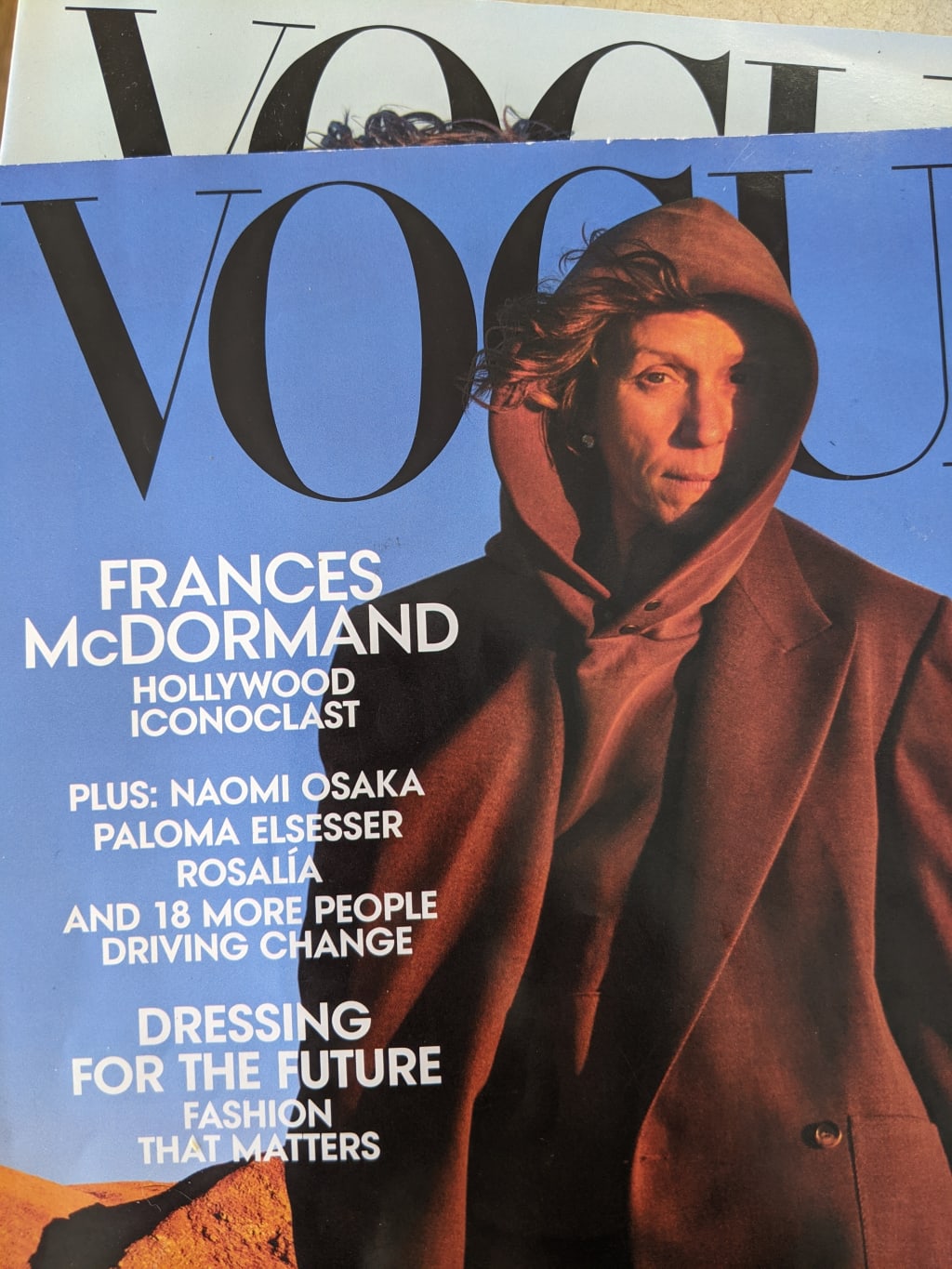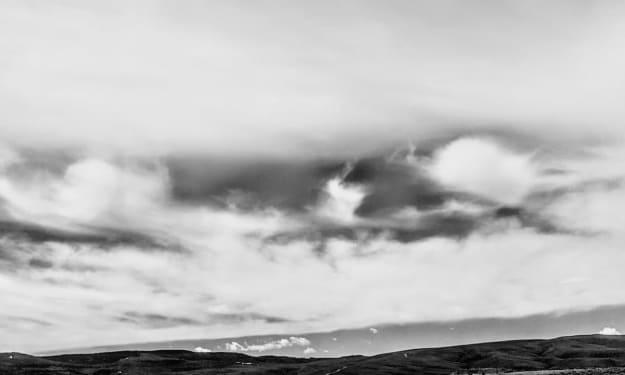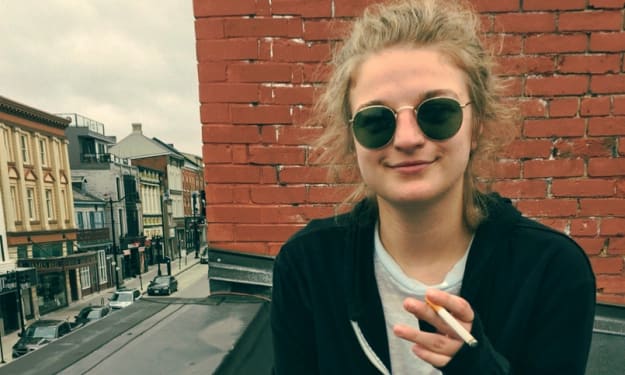Nomadland: Frances is Fern is US
In Appreciation of an Instant Classic

Nomadland: Frances is Fern is US
by Kaley Sutton
2/20/21
Watch Nomadland. It’s exactly the movie we need right now. From the second we press play, we’re captivated by Frances MacDormand and her familiar, unpretty, weathered and real face. We’re fascinated by her honest and clearheaded assessment of her situation. We’re impressed by her frank acceptance and measured decisiveness. Frances McDormand is Fern, who with Chloé Zhao has created an instant classic, a documentary-esque zeitgeist film that has already earned its place among the masterpieces of American cinematography.
I love Nomadland because I understand, more than I want to, what it’s like to move out of a house without another one to move into. The idea of a woman, by herself, simply surviving the only way she knows how, without depending on men, drugs, alcohol, without going crazy, without anger, without denial, draws me in such a way that I’ve started writing a survival book for women. So of course I had to watch Nomadland. I want to see, how does this person do it? I want to see how she accomplishes this unglamorous nomad life. And it is decidedly unglamorous.
We watch, clear as day and seemingly in real time, with no fuss, filter or background music, as Fern lives her life. That’s it. She just lives her life, and we watch. We watch her put boxes in storage, we watch her park at a gas station to sleep, wake up to knocking on her van. We watch her learn how to fix a tire at a nomad camp, shit in a bucket in her van, give a cigarette to a young banjo-bearing nomad, tape boxes in a warehouse and eat lunch in a cafeteria, harvest dirt-covered beets, scrub campground bathrooms. None of this sounds interesting. That’s what makes it fascinating. We get to not just watch Fern’s life, but experience it, exactly as she does, with no bias, no agenda, no filter. It’s not even presented in a voyerustic way, rather, it’s as if we present, as if we are there, right next to Fern, life-sized in the familiar yet ever-changing landscape of America, from the Arizona desert to snowy Nebraskan tundras. There, right alongside our friend Fern, we meet the rugged and real faces of America.
What I love about Nomadland is that the film honors an entire class of people who haven’t had their stories told. Nomadland pays tribute to unwealthy, unpretty, unsuccessful, people by simply paying attention to them. Nomadland dignifies these Americans simply by acknowledging them, by seeing them, by hearing them. We, in turn, are dignified. We, by extent, are given permission to simply survive, to simply exist. Nomadland normalizes normality and reminds us that we don’t have to be physically attractive, monetarily wealthy, or giddy with happiness. Nomadland sees us, accepts us Americans, exactly what we are.
I currently live in rural Wyoming with more horses than houses in sight, and I relish the monthly arrival of Vogue magazine for a glimpse of the world outside the ranch. I read about fashion, female leaders, bestselling books, and of course, modern actors. When in January I saw, not a shiny young woman gracing the illustrious front cover but rather, a mysterious Mona Lisa smile on a glowing-yet-rugged, androgynous face in front of a cloudless blue desert sky and red desert rock, I was captivated. Who is that? They (as in, third-person genderless singular) gaze at us with that enigmatic half-smile, only one eye visible from underneath a high, sexless eyebrow, arched as if they’re asking you a question only they know the answer to. Only one eye visible under that eyebrow, underneath an auburn hood that matches, in perfect monochrome, windblown auburn hair of unknowable length under auburn hood, under auburn jacket and auburn pants. It’s fascinating how none of it—none of it— not the hair, not the clothes, not the skin, not the lips, not the eyes, none of it gives us any clue as to the sex of this person (why must we feel we know?). We beg to ask — Who is that? Is this tall mysterious creature a pockmarked (from drugs?) young man? Is it a….woman? A woman, not wearing makeup, not trying to be pretty, not feminine, not sexy? On…the cover of Vogue? McDormand’s cryptic Mona Liza gaze and unflinching androgyny challenges us, provides us with a third option, frees us from black and white binary thinking of male/female, old/young. She (it’s strange even to assign her a gendered pronoun, rude almost, to label her in any way) is somehow, everything — a human who has perfectly balanced masculine and feminine features. In Nomadland, Frances McDormand gives Fern a quiet, almost reluctant strength, and though she often seems at unease, almost trembling with fragility like a small bird under unflattering jeans and layers of drab, nondescript, androgynous garments, yet she always hold her ground. Her sister, a different kind of American normal, of the polished, comfortable, middle-class flavor, tells her in a tender moment, “You were different. You were braver, more honest.” How fitting it is that McDormand’s plain portrayal of frank Fern in real America is as refreshing as a cool glass of water on a hot desert day. Fern could not be more plain, yet she remains mysterious in her genuineness, fascinating in her plainness, uniquely embodying normalness. Despite her entirely average, androgynous short hair and layers of genderless and nondescript clothes, Fern is instantly recognizable to anyone with whom she’s ever come in contact. She never tries to be nice, she doesn’t try to be pretty, she doesn’t feel sorry for herself or exaggerate or manipulate or make excuses. She just has normal interactions with normal people. There is no sex, no violence, no gore, no lust. Just a person, living, not thriving, just surviving. Like us.
Thus Nomadland watches more like a documentary than a film. Fern is so realistic, so familiar that my partner asked within in minutes who the movie it was based on. Though he watched patiently the entire film I could tell he was bored. This, I could almost hear him thinking, is just normal people. This is just normal life. And the thing is, that’s the point. We watch as Fern, instantly familiar to us, travels to and through real, recognizable American places. We almost never watch her traveling between places, though we know she drives. She simply appears in a new location, and we must try to keep up. The surprise is, that we can. We know these places without a sign, without their names. For those of us who have road tripped across this great country, the places are easily identified by the American viewer. The places are familiar as Fern. From the saguaro cacti of the Arizona desert to the otherworldly rock formations of Wyoming, we get the sense, I’ve been here before. I’ve met her before. Nomadland simply, without bias or judgement, shows us America. Fern just reminds us of ourselves. Fern is neither attractive nor repulsive. Fern is not sad, or angry, or drunk, or stoned. Fern simply is, and thereby gives us permission to be ourselves too.
I almost want to say that this movie celebrates clue-collar America, but the word “celebrates” is too strong, too bright, too cheerful. Nomadland simply shows us, like a mirror, what America is. Not the America we want to be. Not the America we show to others. Not our favorite America. Not the glamorized, shiny America, not the America of Beverly Hills and beautiful people, but the unglamorous, everyday, almost-ugly, rugged, real America. The America we don’t show on TV, the America we pretend doesn’t exist but which surrounds us, which contains us, which sustains us. The America where people live in their vehicles and work low-paid seasonal jobs with other very real people. The folks that Fern meets are the people that we ourselves have met. They, and vicariously we, share their stories around a campfire. They, and we, honor a generous friend fallen to cancer. They, and we, clock in for work at a shitty job, without pride or regret, out of respect for its necessity. They, and we, share pizza and a laugh with co-workers, sit in lawn chairs and drink a beer, watch country music on a small stage while everyday people poorly square-dance in a nondescript country bar. It’s all so familiar, so normal. Again, that’s exactly the point.
What I loved about Nomadland (besides the refreshing, frank normalcy, the enigmatic Frances McDormand, the Ludivico Einaudi soundtrack, the cinematography, and the landscapes) was the stories. Fern meets a lot of people as a nomad, and she learns their stories. We watch as she, entirely unheralded, doles out respect, hope and help to the rough and real people she meets, simply by accepting them as she accepts herself. She is so subtle that her acts of kindness are too normal to even notice. In fact, the entire film is so low-key that Fern’s giddy, childlike excitement at watching a friend feed meat to a captive alligator, jars us into realizing how easily we’ve become captivated by this quiet, calm, utterly normal person. We’ve become accustomed to her placid presence, and it comforts us. To see Fern in rare expression of emotion, of excitement, is unexpected, and we realize we’ve grown used to her calm acceptance of her unfortunate circumstances. Fern’s honest acceptance of her own life makes us realize that it’s okay to be not okay.
Nomadland asks us, what if the worst thing happens? What if your loved one dies, your town disappears, what if you lose everything? Watching Nomadland makes us realize that if Fern can do hard things, we too can do hard things. We too, can ruggedly survive when worse comes to worse. Though she lives in her van, her van does not define her. Without the youthful romanization of “van life,” there is no Instagram filter, no trending hashtags, not a smartphone in sight. The van itself, although mentioned, (one woman asks “what’s your van’s name?” suddenly in conversation, knowing it has a name) is respected, is necessary, is taken care of, but is not glamorous. Nor is it denigrated. It is simply what it is — where Fern lives. When Paint (“cause she takes me where I ain’t”) has engine failure and is taken into the auto shop, the unsympathetic mechanics, leaning back in their chairs, advise her to “take the money and put it in a new car.” They’d quoted her over $2,000, and that is not something that Fern can pull out of her pocket. She holds her ground for several minutes, becomes about as agitated as we ever see her (from a 1 to at 2 out of ten) and bursts in her characteristic conciseness, “It’s where I live.” It’s more than a van. It’s her home.
It makes us think, what is home? That is the question Nomadland forces us rot ask. That’s the question Fern brings up to us, to her family, to everyone she meets, even to her previous home. That’s the open-ended question with no single answer. What is home? We all ask. At one point, Fern stays with a friend’s family for a while and we watch her uncomfortable entry into another kind of normal — the middle-class house-and-family kind — as she eats traditional Thanksgiving dinner with the family, who laugh and chatter around the table, the house full of light and love. Then, later, suddenly, everyone is gone. Fern walks around the house and we see signs of life, of love, of family — baby’s toys on the floor, a mug on a desk, an empty kitchen, a silent dining room. What makes a house a home? It’s not the walls, or the table, or the toys. It’s the people. With no people, what’s the point? What is home? And where?
Fern, unsurprisingly, gets back in her van. She’s alone, and on the road again. And so are we.
About the Creator
Enjoyed the story? Support the Creator.
Subscribe for free to receive all their stories in your feed. You could also pledge your support or give them a one-off tip, letting them know you appreciate their work.






Comments
There are no comments for this story
Be the first to respond and start the conversation.